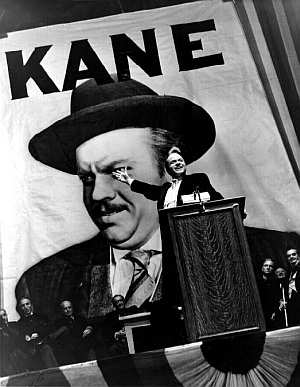
For Thursday, you can write about a specific film if you want, or anything film-related, really. I'm leaving this one wide-open to see what you guys come up with. For mine, see below:
My favorite movie blog is Scanners by Jim Emerson (linked to the right under "Film Blogs") -- he discusses a great mix of contemporary and classic films, he posts pretty frequently, and I always feel like I learn something from his writing and the comments from other readers that follow them. A post that is near and dear to my heart is right
here -- I won't quote ad nauseum, but I'll provide this excerpt, which comes after Emerson wonders why people always ask him, "Why do you like old movies and foreign movies so much?"
I like to counter this narcissistic question with another proposition: "Think of the new music you've heard that's been issued over the last year. Is more of it "better" than what's been made over the last 100 years? Would it be "elitist" to say that it's more likely you'll find more favorites from the last 99 years than from the last one? Even in purely statistical terms, it just makes sense.
I hate to get too defensive over this, but considering I get the same attitude from my family and friends as I do from students, it gets a bit tiring to continually defend watching movies I genuinely like. If you're wondering why we're watching old movies like Citizen Kane instead of 300 in class, I hope you'll remember Emerson's quote about music.
Recently, he participated in a poll of online film writers to "determine" the best foreign-language films. You can read the whole post
here, but for funsies, here's the list the 174 writers came up with. See how many titles you recognize:
1. "The Rules of the Game" (Jean Renoir)
2. "Seven Samurai" (Akira Kurosawa)
3. "M" (Fritz Lang)
4. "8 1/2" (Federico Fellini)
5. "Bicycle Thieves" (Vittorio De Sica)
6. "Persona" (Ingmar Bergman)
7. "Grand Illusion" (Jean Renoir)
8. "Aguirre, the Wrath of God" (Werner Herzog)
9. "The Battle of Algiers" (Gillo Pontecorvo)
10. "The 400 Blows" (Francois Truffaut)
11. "Fanny and Alexander" (Ingmar Bergman)
12. "Tokyo Story" (Yasujiro Ozu)
13. "Rashomon" (Akira Kurosawa)
14. "Ikiru" (Akira Kurosawa)
15. "The Seventh Seal" (Ingmar Bergman)
16. "Ran" (Akira Kurosawa)
17. "Jules and Jim" (Francois Truffaut)
18. "The Conformist" (Bernardo Bertolucci)
19. "La Dolce Vita" (Federico Fellini)
20. "Contempt" (Jean-Luc Godard)
21. "Breathless" (Jean-Luc Godard)
22. "Ugetsu Monogatari" (Kenji Mizoguchi)
23. "Playtime" (Jacques Tati)
24. "Au Hasard, Balthazar" (Robert Bresson)
25. "Andrei Rublev" (Andrei Tarkovsky)
For the record, we're watching two titles that are in the Top 10 in The Art of Film I: M and The Battle of Algiers. The director of the film at No. 9, Werner Herzog, is the subject of the documentary Burden of Dreams, another film we're watching here. We'll watch Ran in The Art of Film II. Also, the 400 Blows is also part of the English 10 curriculum. What I'm trying to say is that we as English teachers have impeccable taste in film.
Kidding. Relax.















